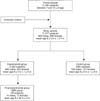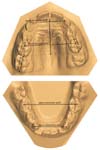1. Bjerklin K, Kurol J. Ectopic eruption of the maxillary first permanent molar: etiologic factors. Am J Orthod. 1983; 84:147–155.

2. Kurol J, Bjerklin K. Ectopic eruption of maxillary first permanent molars: a review. ASDC J Dent Child. 1986; 53:209–214.
3. Bjerklin K, Kurol J. Prevalence of ectopic eruption of the maxillary first permanent molar. Swed Dent J. 1981; 5:29–34.
4. Pulver F. The etiology and prevalence of ectopic eruption of the maxillary first permanent molar. ASDC J Dent Child. 1968; 35:138–146.
5. Salbach A, Schremmer B, Grabowski R, Stahl de Castrillon F. Correlation between the frequency of eruption disorders for first permanent molars and the occurrence of malocclusions in early mixed dentition. J Orofac Orthop. 2012; 73:298–306.

6. Barberia-Leache E, Suarez-Clúa MC, Saavedra-Ontiveros D. Ectopic eruption of the maxillary first permanent molar: characteristics and occurrence in growing children. Angle Orthod. 2005; 75:610–615.
7. Chintakanon K, Boonpinon P. Ectopic eruption of the first permanent molars: prevalence and etiologic factors. Angle Orthod. 1998; 68:153–160.
8. Martins-Júnior PA, Marques LS. Clinical implications of early loss of a lower deciduous canine. Int J Orthod Milwaukee. 2012; 23:23–27.
9. Miyamoto W, Chung CS, Yee PK. Effect of premature loss of deciduous canines and molars on malocclusion of the permanent dentition. J Dent Res. 1976; 55:584–590.

10. Yuen S, Chan J, Tay F. Ectopic eruption of the maxillary permanent first molar: the effect of increased mesial angulation on arch length. J Am Dent Assoc. 1985; 111:447–451.

11. Canut JA, Raga C. Morphological analysis of cases with ectopic eruption of the maxillary first permanent molar. Eur J Orthod. 1983; 5:249–253.

12. Raghoebar GM, Boering G, Vissink A, Stegenga B. Eruption disturbances of permanent molars: a review. J Oral Pathol Med. 1991; 20:159–166.

13. Mooney GC, Morgan AG, Rodd HD, North S. Ectopic eruption of first permanent molars: presenting features and associations. Eur Arch Paediatr Dent. 2007; 8:153–157.

14. Valmaseda-Castellón E, De-la-Rosa-Gay C, Gay-Escoda C. Eruption disturbances of the first and second permanent molars: results of treatment in 43 cases. Am J Orthod Dentofacial Orthop. 1999; 116:651–658.

15. Bjerklin K, Kurol J, Valentin J. Ectopic eruption of maxillary first permanent molars and association with other tooth and developmental disturbances. Eur J Orthod. 1992; 14:369–375.

16. Baccetti T. A controlled study of associated dental anomalies. Angle Orthod. 1998; 68:267–274.
17. Becktor KB, Steiniche K, Kjaer I. Association between ectopic eruption of maxillary canines and first molars. Eur J Orthod. 2005; 27:186–189.

18. Baccetti T, Franchi L, Mc Namara JA Jr. The cervical vertebral maturation (CVM) method for the assessment of optimal treatment timing in dentofacial orthopedics. Semin Orthod. 2005; 11:119–129.

19. Mucedero M, Ricchiuti MR, Cozza P, Baccetti T. Prevalence rate and dentoskeletal features associated with buccally displaced maxillary canines. Eur J Orthod. 2013; 35:305–309.

20. Kurol J, Bjerklin K. Ectopic eruption of maxillary first permanent molars: familial tendencies. ASDC J Dent Child. 1982; 49:35–38.
21. Tweed CH. Clinical orthodontics. 3th ed. St. Louis: The CV Mosby Company;1966.
22. Moyers RE. Handbook of orthodontics. 4th ed. Chicago: Year Book Medical;1988.
23. Tollaro I, Baccetti T, Franchi L, Tanasescu CD. Role of posterior transverse interarch discrepancy in Class II, Division 1 malocclusion during the mixed dentition phase. Am J Orthod Dentofacial Orthop. 1996; 110:417–422.

24. Donatelli RE, Lee SJ. How to report reliability in orthodontic research: Part 1. Am J Orthod Dentofacial Orthop. 2013; 144:156–161.





 PDF
PDF ePub
ePub Citation
Citation Print
Print









 XML Download
XML Download